by Selena Rodriguez (originally published in March 2017 issue of CSU Life)
It’s easy to feel disconnected from history. With years and years separating us from events of the past, it can feel more like a mystifying story that an actual piece of time and space. We can read tales of the Roman Era or the Wild West, but never truly grasp that it actually happened. We might forget that real people, just like me and you, actually lived through these surreal points in time. History becomes a ghost. People talk about it in broad sweeps but forget about all the people that molded it. Emotion and empathy are hard to forge when so often the witnesses are lost in the sands of time.
In the ghetto
Starr was born in 1922 in Lodz, Poland. She had three sisters and two brothers. When Lodz ghetto was established in 1939, she was only a teenager. In an interview before her speaking event, Starr recalled that they rarely ate during their stay at the ghetto. Once a month her family would stand in line, hoping to get their hands on some food. In the ghetto, the residents were forced into slave labor.
But on Feb. 22, Colorado State University got the chance to connect with the past in a very personal way. In honor of the 20th annual Holocaust Awareness Week, the Students for Holocaust Awareness, Chabad Jewish Student Association and Hillel put on an Evening with a Holocaust Survivor. This year’s featured speaker was Mrs. Fanny Starr, a survivor of several Nazi concentration camps. In an effort to combat anti-Semitism and deniers while promoting peace and hope, the 95 year began sharing her first hand account of the Holocaust. She shared the grim details of slave-labor, torture and mass murder.

Starr was tasked with tearing apart clothes from concentration camps in search of hidden valuables. She would find gold, gems and diamonds sewn into the clothes. Little did she know, this was a grim foreshadowing of what would happen next. When her time at the ghetto was up, Starr and roughly 60 others crammed into a train car. Once Starr reached her destination, her eyes fell on a sign:“arbeit macht frei,” or “work will set you free.” She was at the gates of the infamous Auschwitz concentration camp. This is where she encountered Dr. Mengele, a nefarious physician known to torture children in cruel experiments. He wore a black uniform with a hat emblazoned with a swastika. He was the one to determine who would live and who would be cast off to the gas chamber.
“My youngest sister pinched my cheeks and I pinched hers,” Starr recounted, explaining that they were trying to look more alive. When Dr. Mengele reached her, he approved her to work. But much of her family didn’t make it past his judgment. In an instant, she lost her mother, father, older sister, brothers and much of her extended family. Starr shed a tear as she recalled their fate. She said that once they parted ways, she was sent to a warehouse, forced to remove her clothes and given a striped uniform. This was the start of her grueling internment.
In several camps
Starr and her younger sister Rena Alter moved back and forth among a number of concentration camps. She recounted the atrocities they to the capacity crowd in the Lory Student Center Ballroom. Death ran rampant, ash from the ovens rained down from the sky and little hope existed. Even after her liberation, Starr felt the impact of the horrors she witnessed. When she was living in the displaced persons’ camp at Bergen-Belsen, Germany, Starr collapsed under the weight of all the suffering and felt like giving up.
“Shall I go right, shall I go left? What can I do? What is my future,” Starr remembered thinking. She didn’t want to live anymore. But her sister didn’t let her succumb to those negative thoughts. Alter hoisted her up by the collar and proclaimed, “This is our life.” When Starr still didn’t respond, she slapped her face and repeated it again. Starr says that her sister saved her life that day. She went on to meet her husband, Zesa Starr, in the displaced person’s camp, and they eventually settled in Denver.
“It took a long time to adjust,” Starr said when asked how she healed from such a traumatic experience. But despite it all, Starr still manages to smile, a sense of radiance still alive within her. When asked about why she still talks, she says she wants to help fight
anti-Semitism. She says she still sees it in the world and hopes her story helps to alleviate that.
A light unto others
“I am always very impressed with the incredible strength and optimism of Holocaust survivors,” Alex Amchislavskiy, who helped organize Holocaust Awareness Week, stated. He said this was a showcase of “Jewish resilience” and a way to combat the hate many people face around the world for just being who they are. “Instead of spreading hate, we should ‘be a light unto others’ and fight for a more just world.”
Starr’s willingness to speak out brings history to life. It reminds us what hate can cause. As she continues to spread her story, the lessons of the past can carry on in a tangible way. Like a ripple in a pond, her words have the potential to reverberate through our world. And perhaps those who hear her speak will take up the mission for peace, creating their own ripples as well.
Back to Holocaust Awareness Week Page.